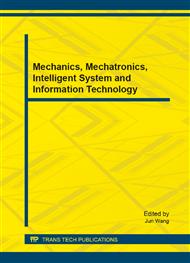[1]
Gan M G, Chen J, WANG Y N, et al. A target tracking algorithm based on mean shift and normalized moment of inertia feature [J]. Acta Automatica Sinica, 2010, 36(9): 1332-1336.
DOI: 10.3724/sp.j.1004.2010.01332
Google Scholar
[2]
Karavasilis V, Nikou C, Likas C. Visual tracking by adaptive Kalman filtering and mean shift [J]. Lecture Notes in Computer Science, Artificial Intelligence: Theories, Models and Applications, 2010, 6040: 153-162.
DOI: 10.1007/978-3-642-12842-4_19
Google Scholar
[3]
Senior A, Hampapur A, Tian Yingli, et al. Appearance models for occlusion handling [J]. Image and Vision Computing, 2006, 24(11): 1233-1243.
DOI: 10.1016/j.imavis.2005.06.007
Google Scholar
[4]
Gross R, Mattews I, Baker S. Active appearance models with occlusion [J]. Image and Vision Computing, 2006, 24(6): 593-604.
DOI: 10.1016/j.imavis.2005.08.001
Google Scholar
[5]
Khan M S, Shah M. Tracking multiple occluding people by localizing on multiple scene planes [J]. IEEE Transactions on Pattern Analysis and Machine Intelligence, 2009, 31(3): 505-518.
DOI: 10.1109/tpami.2008.102
Google Scholar
[6]
An G C, Zhang F J, Wang H A, et al. Multi-window target tracking[J]. Journal of Computer Research and Development, 2011, 48(11): 2023-(2030).
Google Scholar
[7]
Phadke G. Robust multiple target tracking under occlusion using fragmented mean shift and Kalman filter [A]. 2011 International Conference on Communications and Signal Processing[C]. 2011, 2: 517-521.
DOI: 10.1109/iccsp.2011.5739376
Google Scholar
[8]
Yan J, Wu M Y, Chen S Z, et al. Anti-occlusion tracking algorithm based on mean shift and fragments [J]. Optics and Precision Engineering, 2010, 18(6): 1413-1419.
Google Scholar
[9]
Qi M B, Zhang L, Jiang J G, et al. Target template update method in fragment tracking [J]. Journal of Image and Graphics, 2011, 16(6): 976-982.
Google Scholar
[10]
Li Y Z, Lu Z Y, Li J. Robust video object tracking algorithm based on multi-feature fusion [J]. Journal of Xidian University, 2012, 39(4): 1-6.
Google Scholar
[11]
Fisher R. Caviar Test Case Scenarios [DB/OL]. [2011-12-05]. groups. inf. ed. ac. uk/vision/ CAVIAR/CAVIARDATA1.
Google Scholar
[12]
Birchfield S. Elliptical head tracking using intensity gra-dients and color histograms[C]/Proc of IEEE computer society conference on computer vision and pattern recognition. Santa: IEEE, 1998: 232-237.
DOI: 10.1109/cvpr.1998.698614
Google Scholar


